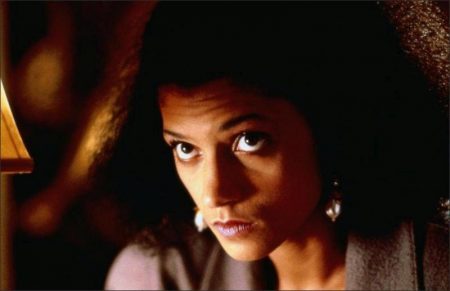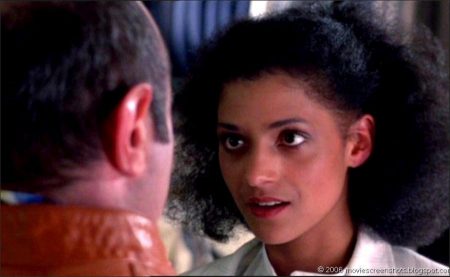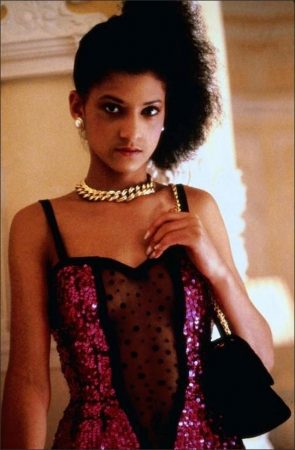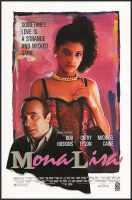Taglines: She was a tart. He was an ex-con. And she was about to shatter his life forever.
Mona Lisa movie storyline. George (Bob Hoskins), a low-level working-class gangster recently released from prison, is given a job by his former boss, Denny Mortwell (Michael Caine), as the driver and bodyguard for a high-priced prostitute named Simone (Cathy Tyson). Mortwell also wants George to gather information on one of Simone’s wealthy customers for blackmail purposes.
Simone, who has worked hard to develop high-class manners and an elite clientele, initially dislikes the uncouth and outspoken George, and he regards her as putting on airs. But as George and Simone find out more about each other, they form a friendship, and George begins to fall in love with her. George agrees to risk his own life to help Simone find her teenage friend Cathy (Hardie), who has disappeared, and whom Simone fears is being abused by her violent former pimp, Anderson (Peters).
George increasingly finds himself torn between his feelings for Simone, his obligations to his boss Mortwell, and his relationship with his teenage daughter Jeannie, a sweet normal girl who has matured while he was in prison and wants to have her father in her life. When George finally finds Cathy and reunites her with Simone, he discovers that Simone and Cathy are lovers, and that Simone doesn’t care about him and only used him to find Cathy.
Mortwell and Anderson then arrive to take back control of Simone and Cathy, and an enraged Simone shoots them both and then threatens to shoot George, but he punches her, takes the gun and leaves, upset at her ingratitude. Freed of his underworld obligations, George returns to a more normal life, working in his friend’s garage and spending time with Jeannie.
Mona Lisa is a 1986 British neo-noir crime drama film about an ex-convict who becomes entangled in the dangerous life of a high-class call girl. The film was written by Neil Jordan and David Leland, and directed by Jordan. It was produced by HandMade Films and stars Bob Hoskins, Cathy Tyson, and Michael Caine.
The film was nominated for multiple awards, and Bob Hoskins was nominated for several awards for his performance (including the Academy Award for Best Actor), winning the Golden Globe Award for Best Actor – Motion Picture Drama and BAFTA Award for Best Actor in a Leading Role.
Film Review: Mona Lisa
NEIL JORDAN’S ”Mona Lisa” is classy kitsch. It’s as smooth and distinctive (and, ultimately, as insubstantial) as the old Nat (King) Cole recording of the song, which gives the film its title and a lot of its mood. It’s also got high style, so you needn’t hate yourself for liking it.
Though ”Mona Lisa” opens today at the Cinema 1, it’s the sort of movie that might be best watched at 3 A.M., on a small screen, while sitting alone in an anonymous bar, nursing a warm glass of beer, feeling sorry for the world and even sorrier for yourself. When you think about it afterward, it’s utterly preposterous.
The setting is London. George (Bob Hoskins) is a short, bullet-shaped, petty hood with a nasty temper. He talks tough and knows how to handle himself in the sleazy, violent world he inhabits. His masculinity is a serious business as well as his protection.
Underneath all, however, George is almost fatally sentimental. He’s also as genteel as the lace doily that, in a working-class house, protects the back of the easy chair from the grease dad puts on his hair.
George has been around – at the start of ”Mona Lisa” he’s just finished serving a seven-year prison term – but there are some things he simply cannot tolerate. It’s what George can’t tolerate that provides the film with its ending (and its letdown).
”Mona Lisa” is a romantic kind of shaggy-dog fable about the unlikely relationship that grows up between George and Simone (Cathy Tyson), the tall, beautiful, reed-thin black hooker, to whom he’s assigned as a chauffeur by his mob boss. At first George is cool to Simone, whom he dismisses as just another ”black tart.”
As George drives Simone from one high-paying assignment to the next, he’s alternately haughty and sarcastic, but there’s no slur that Simone hasn’t heard before, said more effectively, by someone else. She’s always in control of herself. George is humiliated when she criticizes his flashy taste in clothes, but he also admires her combination of utter streetwise frankness and elegant manners. Before long, he’s in love with her.
As if to certify his feelings for Simone, he tells his pal Thomas that Simone is a lady. ”I thought you said she was a tart,” says the always logical Thomas. ”She is,” says George, ”but she’s also a lady.”
When Simone asks George to find a 15-year-old prostitute named Cathy, who’d been Simone’s only friend when she was still walking the streets, George risks life and limb in a hunt through London’s underworld that becomes, in his eyes, a quest for the Holy Grail.
Like ”The Company of Wolves,” Mr. Jordan’s series of spectacularly ornamented variations on the story of Little Red Riding Hood, ”Mona Lisa” is as much about the telling of tales as about the tales being told. George and his friend Thomas, who deals in bizarre stolen goods (including plastic Jesus figures that can be lighted within), pass the time making up mystery stories for each other. Each insists on logic in the other’s tales, as well as on endings that tie up all loose threads.
”Mona Lisa” itself becomes George’s story, lived by him to be judged eventually by Thomas. This is more interesting as an idea for a movie than it is to watch as a movie, possibly because it has the effect of denying the immediate emotional importance of just about everything that happens within the film.
”Mona Lisa” is less a true film noir than a comment on one. It’s as bloodless as an abstract theory. However, though ”Mona Lisa” is hardly ever involving, it is fun to watch, mostly for its performances.
As good as Mr. Hoskins is, and he is splendid (he shared the best-actor award at this year’s Cannes Film Festival for his work in this film), he doesn’t carry ”Mona Lisa” alone. Miss Tyson (the English-born niece of Cicely Tyson) has a magical film personality, which, here, is beautiful, intelligent and hard as nails. In their scenes together, Mr. Hoskins and Miss Tyson come very close to making the preposterous appear to be both significant and moving.
In a comparatively small role, that of Mortwell, the cooly vicious chief of a gang of London pimps and blackmailers, Michael Caine adds his own class to the melodrama. Behaving (initially) as if he were removed from the events we are seeing, Mr. Caine seems to be visiting the film with as much reluctance as Mortwell deals with the troubles caused him by George and Simone. The actor’s presence shapes the film as much as anything he’s required to say or do.
Also very good are Kate Hardie, as a teen-age hooker-junkie at the end of her rope; Clarke Peters, as a black pimp, and Robbie Coltrane, as George’s eccentric, fable-spinning friend.
”Mona Lisa” looks terrific. It has Nat (King) Cole on the soundtrack. It has vividly realized characters behaving in unexpected ways. Yet the excitement doesn’t build – it runs down. It’s like watching the departure of an ocean liner. After all of the initial excitement, you’re left on the dock, alone, wondering what all the fuss was about.
Mona Lisa (1986)
Directed by: Neil Jordan
Starring: Bob Hoskins, Cathy Tyson, Michael Caine, Robbie Coltrane, Clarke Peters, Kate Hardie, Zoë Nathenson, Sammi Davis, Pauline Melville
Screenplay by: Neil Jordan, David Leland
Production Design by: Jamie Leonard
Cinematography by: Roger Pratt
Film Editing by: Lesley Walker
Costume Design by: Louise Frogley
Set Decoration by: Gemma Jackson
Art Direction by: Gemma Jackson
Music by: Michael Kamen
Distributed by: Island Pictures
Release Date: June 13, 1986
Views: 613






